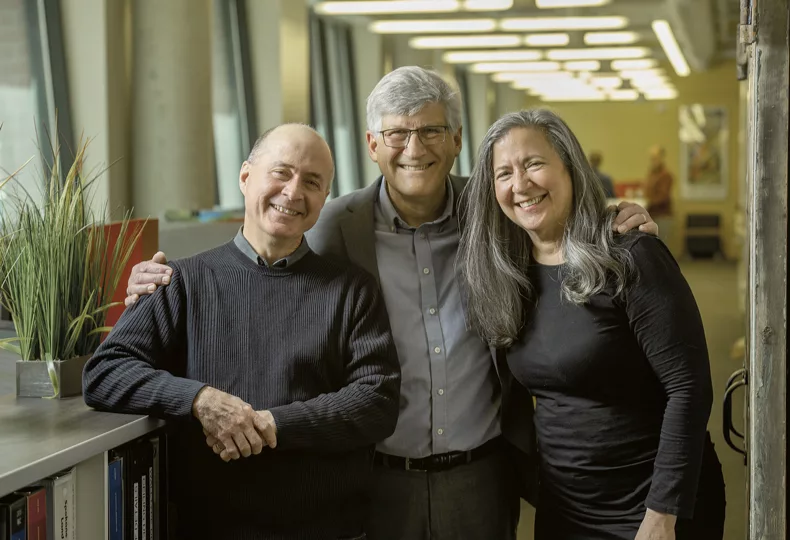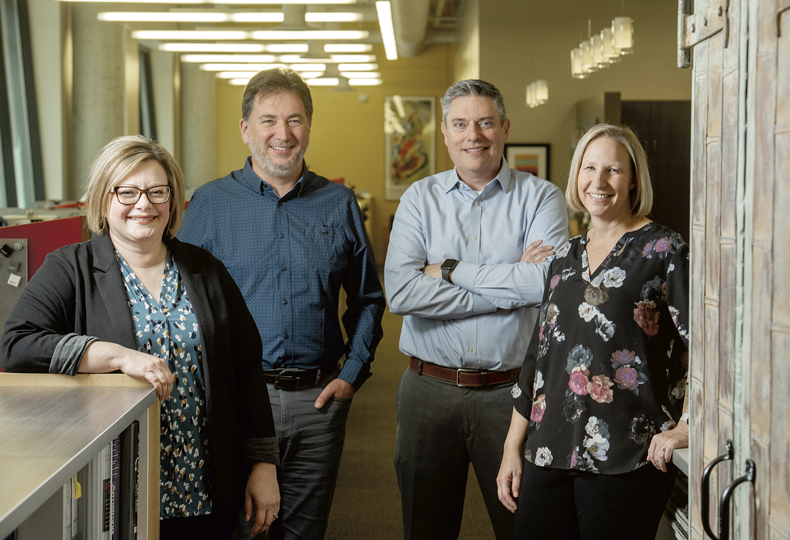Succession by design at MMEC Architecture
Firm’s founders reflect on culture, legacy while passing baton to next generation

From left, MMEC Architecture & Interiors LLC founding principals Doug Mitchell, Craig Conrad, and Marian Evenson have retired from the firm.
| Hamilton StudioMMEC Architecture & Interiors LLC’s three remaining founding partners retired in July, marking the end of an era at the Spokane-based firm.
Doug Mitchell, Marian Evenson, and Craig Conrad—who make up the second M, the E, and the C in MMEC—founded the firm in 1999 with Sue Lani Madsen, who retired in 2009.
“We had kind of a plan—not necessarily to do it all at the same time—of how the three of us would exit,” Mitchell says.
The 24-year-old firm is being left in the hands of Jenny Cox, Walt Huffman, Boyd Lusarreta, and Heidi Pierce. Huffman has been a partner since 2011, and the other three were made partners in 2016.
“That was always the plan, to make sure that the four of us were all in place and established before they started exiting,” says Lusarreta.
Handing over the reins to a team that has over 30 years of combined leadership experience at MMEC made the transition easier for the founding partners, Conrad says.
“The only way that it works is because it’s in such good hands,” Conrad says. “The next generation of principals is so qualified. They’ve been in this room helping make difficult decisions for over six years.”
 From left, Heidi Pierce, Boyd Lusarreta, Walt Huffman, and Jenny Cox are the partners who have taken over management of MMEC Architecture & Interiors PLLC.
From left, Heidi Pierce, Boyd Lusarreta, Walt Huffman, and Jenny Cox are the partners who have taken over management of MMEC Architecture & Interiors PLLC.MMEC is located at 1 N. Monroe, in the former Spokesman-Review production facility. It also has an office in Kennewick, Washington. The firm has a total of 16 employees between its two offices.
Before founding MMEC, which originally was named Madsen, Mitchell, Evenson & Conrad PLLC, the three recently retired partners had worked together since the early 1980s, Evenson says.
“We all brought something a little bit different,” Evenson says. “It was really hard to start a firm at that time, but fortunately, we had contacts with good clients.”
MMEC has worked on municipal, commercial, and more recently multifamily projects over the years, but the firm’s largest contributions have been in the education sector, says Cox, who is the firm’s business manager as well as the first employee hired by the founding partners.
“There was a time where we were a good 75%, 80% education, including higher ed,” Cox says. “We have a relatively large, diversified portfolio. It’s just our favorite is education.”
Spokane Public Schools has been a major client for MMEC, Evenson says. One of the firm’s earliest education projects was the Lidgerwood Elementary School replacement, which “catapulted” MMEC into landing more school projects, including some with Kennewick School District.
“It was all about these little experiences we’ve had along the way that got us to be able to have other projects as we started our firm,” Evenson says.
Successful completion of K-12 projects, as well as connections the partners had made within the architecture industry, led to higher education projects like the Jepson Center addition project at Gonzaga University and the historic Hargreaves Hall update project at Eastern Washington University.
One of MMEC’s earliest clients was Cowles Co., which owns the Journal, The Spokesman-Review, KHQ-TV, and River Park Square, among other companies.
“They contacted me out of the blue and asked us to do some master planning for them, which led to a whole bunch of other projects,” Evenson says.
Other prominent clients of MMEC include Premera Blue Cross, Itron Inc., Central Valley School District, Benton County, and Spokane County.
One of the most notable multifamily projects MMEC has completed was the conversion of the Chronicle Building, at 926 W. Sprague, into an apartment building. The project holds even greater importance to Conrad, who had worked on the building in the early ’80s while at ALSC Architects.
“What was meaningful to me was working on the third part of that Chronicle Building and then to have my son, who was a baby at the time, now living in it with his girlfriend,” Conrad says.
While much of the legacy of the founding partners will appear in the form of the buildings they worked on, the culture they created at MMEC won’t be forgotten under the current partners’ leadership, Lusarreta says.
“It’s the reason why we’re here,” he says. “We wanted to work here.”
One aspect of MMEC’s culture was the importance of allowing staff to maintain a healthy balance between their work life and family life, Conrad says. He says the partners didn’t want to create an expectation that employees had to be at work 50 hours a week.
Evenson drew from her own experiences at her former firm to help instill a healthy work-life balance at MMEC.
“I started working in a professional office in 1980. I had my first child in 1990. I was the first employee in that firm to have a baby, and it was a big deal,” Evenson says. “I remember the partners sitting around the conference room trying to decide what to do with me.”
There wasn’t maternity leave at her former firm at the time, she says, and she didn’t believe it was fair to force people to have to choose between work and having kids.
“That was a real eye opener for me, and I guess as an employer, I didn’t want that to be a big deal, because it shouldn’t be,” Evenson says.
Pierce says she had similar issues at her previous firm, which led to her joining MMEC.
Within the MMEC office, the founding partners made a point of creating a collaborative environment—something the current partners plan to continue doing, Huffman says.
“We’re an open office, we don’t have private offices, we’re all right next to each other,” says Huffman.
MMEC also emphasizes the importance of meshing the architecture work and the interior design work, says Evenson, who was an interior designer for the firm.
“It’s really important that as far as the overall design, that those things are integrated together,” Evenson says. “I know that on every project we did that really well.”
The collaboration between the architects and interior designers isn’t always the industry norm, Pierce says. In fact, some architecture firms don’t even have their own interior designers, she says.
“We started wondering if we really were different by having those so integrated,” Pierce says.
Mitchell, Evenson, and Conrad all agree that the 24 years at MMEC went by fast. Evenson says it felt like just a couple of years, until she thinks back about all the different projects they completed.
The three retirees still have lunch at Domini Sandwiches once a month, and Conrad says they will do so as long as they are alive.


_c.webp?t=1763626051)
_web.webp?t=1764835652)

